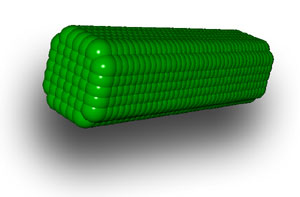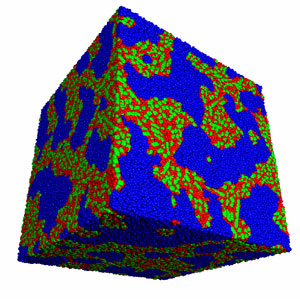Nanoparticle Interfaces and Composites
Structure of Interfaces and Nanoparticles
Dr. Donald R. Franceschetti
The performance of electrochemical sensors in biomedical applications depends crucially on the characteristics of the space charge layers formed on both sides of the interface with the sample as well as the transport and storage of charged and uncharged species at the interface. The electrical, mechanical, and other properties of nanoparticle composites likewise depend on the space charge layers near the surfaces of the component nanoparticles, with the interesting possibility that bulk electroneutrality exists nowhere inside the particles.
Our work is theoretical and computational. A theoretical baseline is provided by solutions of the Nernst-Planck Poisson equation governed by boundary conditions describing interfacial processes and possibly coupled to diffusion equations for neutral reactants or products. This system is well explored in one dimension but must be treated numerically for two- and three- dimensional geometries, coupled to elastic distortions, and corrected for discreteness of charge effects. In additional to mathematical modeling of space charge structures, we have capabilities for nonlinear least squares fitting and interpretation for impedance measurements made on experimental systems.
For more information, please contact Dr. Donald Franceschetti at dfrncsch@memphis.edu, or 901.678.5257.

Nanoparticles in Polymer Blends
It has been suggested that nanoparticles may act as emulsifiers in immiscible polymer blends, allowing the two components to blend at temperatures below the blend's critical temperature. Through large-scale Dissipative Particle Dynamics (DPD) computer simulations, we have seen that nanoscale particles -- particularly those which exhibit geometrical anisotropy as in nanorods -- can greatly slow the phase separation dynamics in a binary polymer blend, and may lead to a micro-phase separated state. These results are not seen for spherically-shaped nanoparticles. We continue to investigate the effects of the addition of nanoparticles to immiscible polymer blends through both theory and numerical simulations (with methods including Molecular Dynamics, Dissipative Particle Dynamics, and Langevin Dynamics). See also the department's research on polymers and polymer blends.
Resources
- 20 node, 3.06 GHz Pentium-4 Beowulf cluster.
- Access to a variety of medium to large scale computer clusters.
Below: A snapshot from a DPD simulation (containing approximately 2,000,000 particles) of a binary immiscible polymer blend containing nanorods.


